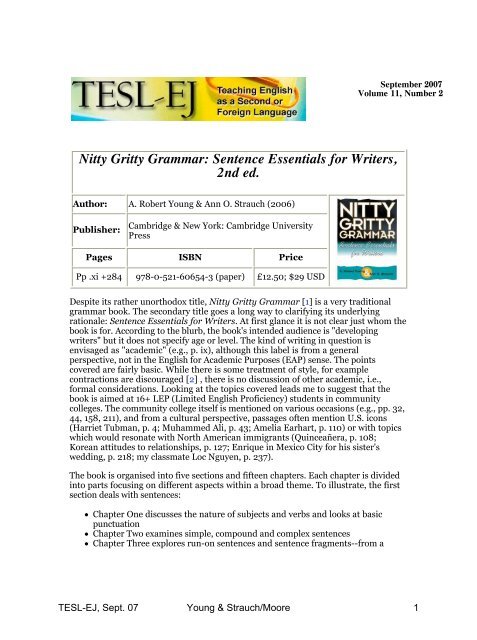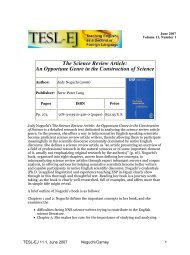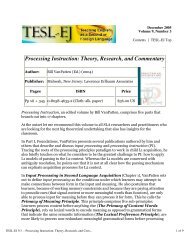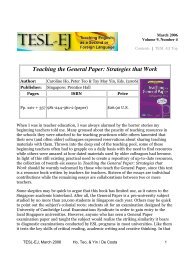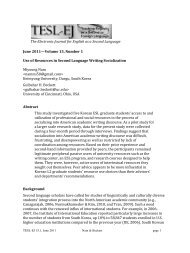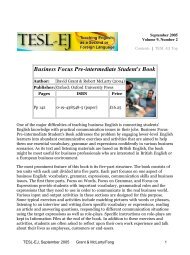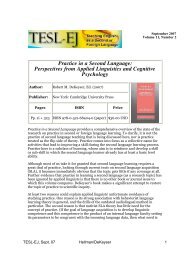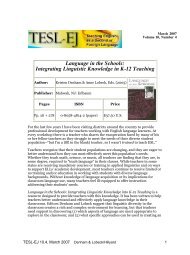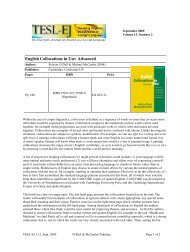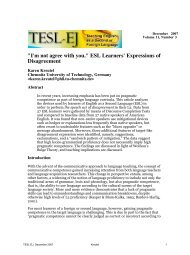Nitty Gritty Grammar: Sentence Essentials for Writers, 2nd ... - TESL-EJ
Nitty Gritty Grammar: Sentence Essentials for Writers, 2nd ... - TESL-EJ
Nitty Gritty Grammar: Sentence Essentials for Writers, 2nd ... - TESL-EJ
Create successful ePaper yourself
Turn your PDF publications into a flip-book with our unique Google optimized e-Paper software.
September 2007<br />
Volume 11, Number 2<br />
Top<br />
<strong>Nitty</strong> <strong>Gritty</strong> <strong>Grammar</strong>: <strong>Sentence</strong> <strong>Essentials</strong> <strong>for</strong> <strong>Writers</strong>,<br />
<strong>2nd</strong> ed.<br />
Author: A. Robert Young & Ann O. Strauch (2006)<br />
Publisher:<br />
Cambridge & New York: Cambridge University<br />
Press<br />
Pages ISBN Price<br />
Pp .xi +284 978-0-521-60654-3 (paper) £12.50; $29 USD<br />
Despite its rather unorthodox title, <strong>Nitty</strong> <strong>Gritty</strong> <strong>Grammar</strong> [1] is a very traditional<br />
grammar book. The secondary title goes a long way to clarifying its underlying<br />
rationale: <strong>Sentence</strong> <strong>Essentials</strong> <strong>for</strong> <strong>Writers</strong>. At first glance it is not clear just whom the<br />
book is <strong>for</strong>. According to the blurb, the book's intended audience is "developing<br />
writers" but it does not specify age or level. The kind of writing in question is<br />
envisaged as "academic" (e.g., p. ix), although this label is from a general<br />
perspective, not in the English <strong>for</strong> Academic Purposes (EAP) sense. The points<br />
covered are fairly basic. While there is some treatment of style, <strong>for</strong> example<br />
contractions are discouraged [2] , there is no discussion of other academic, i.e.,<br />
<strong>for</strong>mal considerations. Looking at the topics covered leads me to suggest that the<br />
book is aimed at 16+ LEP (Limited English Proficiency) students in community<br />
colleges. The community college itself is mentioned on various occasions (e.g., pp. 32,<br />
44, 158, 211), and from a cultural perspective, passages often mention U.S. icons<br />
(Harriet Tubman, p. 4; Muhammed Ali, p. 43; Amelia Earhart, p. 110) or with topics<br />
which would resonate with North American immigrants (Quinceañera, p. 108;<br />
Korean attitudes to relationships, p. 127; Enrique in Mexico City <strong>for</strong> his sister's<br />
wedding, p. 218; my classmate Loc Nguyen, p. 237).<br />
The book is organised into five sections and fifteen chapters. Each chapter is divided<br />
into parts focusing on different aspects within a broad theme. To illustrate, the first<br />
section deals with sentences:<br />
Chapter One discusses the nature of subjects and verbs and looks at basic<br />
punctuation<br />
Chapter Two examines simple, compound and complex sentences<br />
Chapter Three explores run-on sentences and sentence fragments--from a<br />
<strong>TESL</strong>-<strong>EJ</strong>, Sept. 07 Young & Strauch/Moore 1
proscriptive perspective, as "mistakes that people sometimes make in their<br />
writing" (p. 31).<br />
The second, third and fourth sections deal with more typical grammar points: nouns<br />
and articles, tenses, modals and so on. The fifth section is a bit of a lucky dip: it<br />
opens with prepositions, goes on to word <strong>for</strong>mation, and finishes with a selection of<br />
"Final Dos and Don'ts" featuring a selection of "common problems" that have not<br />
been treated elsewhere in the book, e.g., say and tell with direct and indirect objects;<br />
or special, specially and especially.<br />
The design (two colour) and layout of the book are simple, and consistent and<br />
reader-friendly. Each chapter opens with an introduction to the focus, e.g., "The<br />
Future" or "Hope and Wish." If the feature links to points made previously in the<br />
book, there is a "Refreshing Your Memory" section which will encourage recall and<br />
recycling if the book is being used or taught sequentially, and cross-referencing if not;<br />
either way this is a useful device. Next comes one or more short texts designed to<br />
raise students' awareness of the feature. Employing a guided discovery approach the<br />
book gives readers a reflective task in conjunction with the text(s). The rest of the<br />
chapter is broken up into succinct grammar points: "Exploring the <strong>Grammar</strong> Point"<br />
presents another more narrowly focused discovery exercise, followed by<br />
"Understanding the <strong>Grammar</strong> Point," a concise explicit explanation. This is often<br />
accompanied by a "<strong>Nitty</strong> <strong>Gritty</strong>" box that contains the actual rule.<br />
At this point it must be said that the explanation language is not so reader-friendly.<br />
There has been much debate over the use of linguistic metalanguage in a student<br />
grammar reference (e.g., see Berry, 2000; Mohammed, 1996). Generally speaking,<br />
the authors have kept the headings themselves simple although there are a few<br />
exceptions (e.g., "Missing Subjects in Dependent Adverbial Clauses" (p. 36) and at<br />
times the simplicity is perhaps counter-productive. Take "The with Natural Common<br />
Focus," (p. 74). 'Natural Common Focus' (which gets 0 hits on Google) is glossed as<br />
"[W]hen it's unique in the world or when it is common <strong>for</strong> most people in their<br />
everyday environment" (p. 75), which I'm afraid does little <strong>for</strong> Natural Common<br />
Understanding. My main qualms lie with the explanations themselves. At times I find<br />
them dense (e.g., "one or more modifiers may appear between a determiner and a<br />
singular noun" (p. 65); or "Use the be<strong>for</strong>e a singular noun that refers to a part of a<br />
noun that has already been mentioned, or to a closely related noun" (p. 71).<br />
At other times I find the explanations ambiguous. Michael Lewis once said that<br />
grammatical explanations which include "sometimes" are not explanations at all<br />
(1986, p. 177). From that perspective, consider then the potential worth of the<br />
following: "Many dependent clauses begin with a subordinator" (p. 18); "Proper<br />
nouns are usually singular" (p. 65); "Plural proper nouns often take the" (p. 80);<br />
"Most regular verbs . . . " (p. 90); "In some contexts the choice of hope or wish<br />
depends on the writer's opinion about the possibility of an event" (p. 206).<br />
At yet other times I find the explanations questionable, because they seem to go<br />
against what I 'know' and/or because they are overtly reductionist and end up not<br />
presenting a true picture. To illustrate, readers are told, "In negative sentences,<br />
contract have and has with not," which would imply that 've not is not<br />
correct/possible, yet both the American English subcorpus (written) in Cobuild [3]<br />
and the Michigan Corpus of Academic Spoken English (MICASE) [4] contain<br />
<strong>TESL</strong>-<strong>EJ</strong>, Sept. 07 Young & Strauch/Moore 2
examples of 've not. When explaining must and have to <strong>for</strong> requirements, with<br />
reference to the model sentence "I have to do it this weekend," users are told, "You<br />
could also say: I'm requiring myself to do it this weekend": require as a reflexive<br />
verb? Readers are also told that "will is more <strong>for</strong>mal than going to" (pp. 148-9),<br />
whereas surely the difference is functional. Or, "can/cannot expresses ability/inability<br />
in the present and future" (p. 165)--what about be able to?<br />
At the beginning I said that this was a traditional book. It is traditional from various<br />
perspectives: in being sentence-based <strong>for</strong> example, which, as is inevitably the case,<br />
leads to questionable modelling: <strong>for</strong> example, "He hasn't been leaving the house," as<br />
an example of present perfect progressive (p. 132) or, "I could stop <strong>for</strong> only three<br />
days," as an example of past ability (p. 165). These sentences need context; otherwise<br />
they simply do not ring true. On another occasion the sentence "My sister is in the<br />
tenth grade and she went to Sea World last year" (p. 22) is proposed to exemplify<br />
illogical connection, yet in various contexts the two facts would be perfectly logical in<br />
juxtaposition. As a boast, <strong>for</strong> example, or as a correction, or preceding the sentence,<br />
She had a great time but . . . A little bit of context goes a long way.<br />
The authors' attitude towards practise is also very traditional. Exercises are generally<br />
very tightly controlled, often no more than substitution drills, and at times students<br />
are encouraged to produce full sentences in practise exercises even when to do so is<br />
communicatively redundant. As a final point about the traditionalism of this<br />
textbook, it is also highly prescriptive: <strong>for</strong> example, "If I was . . . " : "this is a<br />
common misusage in both written and spoken English" (p. 185). I would hazard to<br />
suggest that it's so common it can no longer be considered 'misusage'. In this case I<br />
believe a comment about <strong>for</strong>mality would have been more appropriate.<br />
At the end of each section there is a "Review" containing extra practice. All these<br />
review sections contain editing exercises. Many of them are introduced as examples<br />
of student compositions to which "mistakes have been added <strong>for</strong> practice." The<br />
mistakes in question always focus on a grammar point dealt with in the preceding<br />
chapters. I cannot help wondering what criteria were used in 'adding' these mistakes.<br />
Are they based on 'real' data such as statistically frequent student errors? At times it<br />
seems almost possible to identify the first language of the writer: the text with the<br />
missing articles 'sounds like' an Asian writer, the text with the missing personal<br />
pronouns 'sounds like' a Spanish or Portuguese speaker. Perhaps I am too keen on<br />
attributing the texts to certain categories of English learners, but it does strike me as<br />
a wasted opportunity <strong>for</strong> a little awareness-raising. If there is ever a third edition, I<br />
would encourage the authors to exploit these typical mistakes by highlighting which<br />
are typical of speakers of certain languages or language families.<br />
Notes<br />
[1] I am surprised by the title. In 2002 the then UK Home Officer Minister John<br />
Denham was criticised <strong>for</strong> using the expression in a public speech, as it was said to be<br />
an old slavery term and thus decidedly un-PC.<br />
[2] Although the book often uses them.<br />
[3] http://www.collins.co.uk/Corpus/CorpusSearch.aspx<br />
<strong>TESL</strong>-<strong>EJ</strong>, Sept. 07 Young & Strauch/Moore 3
[4] http://quod.lib.umich.edu/m/micase<br />
References<br />
Berry, R. (2000). Youser friendly metalanguage. International Review of Applied<br />
Linguistics, 38(3-4), 195- 212.<br />
Mohammed, A. (1996). In<strong>for</strong>mal pedagogical grammar. International Review of<br />
Applied Linguistics, 34(4), 283-291.<br />
Lewis, M. (1986). The English verb: An exploration of structure and meaning. Hove,<br />
UK: Language Teaching Publications.<br />
Pat Moore<br />
Universidad Pablo de Olavide, Spain<br />
<br />
© Copyright rests with authors. Please cite <strong>TESL</strong>-<strong>EJ</strong> appropriately.<br />
<strong>TESL</strong>-<strong>EJ</strong>, Sept. 07 Young & Strauch/Moore 4


